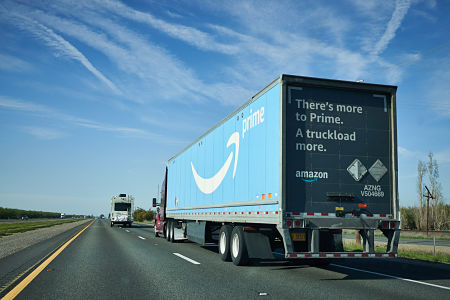Amazon forced to look at big trucking firms for drivers
A crunch in trucking capacity is forcing Amazon to expand its reach for truck drivers, now using larger trucking firms it had previously shunned.
With driver rates on the rise, many of the smaller independent drivers have moved away from Amazon for higher spot rates.
“We work with many small and medium-sized line haul service providers in our transportation network, the majority of which provide dedicated capacity for our network needs, and have long utilized them to carry loads for Amazon,” an Amazon spokesperson said in a statement.
“We also balance remaining capacity needs within our network by offering carriers of all sizes different contract options so that we can serve Amazon demand, while providing carriers with work to drive their business growth,” the spokesperson said.
“They need inventory all at once, and that’s what’s created such a big capacity crunch,” Cathy Roberson, the founder of research firm Logistics Trends & Insights, said in a statement to Business Insider. “The trucking industry had a slow period for a while — then, all the sudden, boom.”
Amazon’s strategy has been to use a network of owner-operators matched to Amazon loads through the company’s proprietary truck brokerage app, Amazon Relay.
Other large retailers employ their own drivers or have on-going partnerships with large public trucking companies. Walmart, for example, has had a long-time partnership with Schneider National, the fifth-largest trucking company in the U.S.
Jake Wilson, co-author of the book, “The Cost of Free Shipping: Amazon in the Global Economy,” says Amazon is increasingly dominating the U.S. supply chain by using its vast database and mass cloud computational capability to consolidate data. In addition, Amazon expands its control of the supply chain by surveillance and control of truckers, air freight pilots, warehouse workers, suppliers, and subcontractors.
Wilson said the Covid-19 pandemic has been a huge boom for Amazon’s business. “This year we saw a dramatic increase in the role that Amazon took in the retail business as brick and mortar stores had to shut down or restrict operations while Amazon expanded its business. During the pandemic, Amazon hired 200,000 workers and rapidly increased its sales while other retailers curtailed their businesses or went out of business.”
Electric in Amazon’s future
While working to corner the U.S. supply chain, Amazon is keeping an eye on climate change. Last month, Amazon announced it was adding more than 1,800 electric vehicles from Mercedes-Benz Vans to its European delivery fleet as part of the company’s Climate Pledge to be net zero by 2040 – a decade ahead of the Paris Climate Accord goal of 2050.
“We welcome the bold leadership demonstrated by Mercedes-Benz by signing up to The Climate Pledge and committing to ambitious action to address climate change. We need continued innovation and partnership from auto manufacturers like Mercedes-Benz to decarbonize the transportation sector and tackle the climate crisis,” said Jeff Bezos, Amazon founder and CEO. “Amazon is adding 1,800 electric delivery vehicles from Mercedes-Benz as part of our journey to build the most sustainable transportation fleet in the world, and we will be moving fast to get these vans on the road this year.”
Mercedes-Benz Chairman Ola Kallenious said, “We stand with Amazon, Global Optimism and the other signatories of The Climate Pledge, in a commitment to being net zero carbon by 2040 – ten years ahead of The Paris Agreement. I am pleased that we will be able to gain even more momentum on our sustainability offensive with this step.”
Amazon’s Delivery Service Partners will have access to the new fleet of zero-emission vehicles to make deliveries to customers in Europe this year, helping to save thousands of metric tons of carbon. The order is a milestone for Mercedes-Benz Vans, marking the largest order of electric vehicles for the manufacturer to date, and makes Amazon its largest sustainable transportation partner worldwide. More than 1,200 EVs in the order will be comprised of the newest electric commercial van available at Mercedes-Benz – the eSprinter, a larger model than the manufacturer’s first zero-emission vehicle, the eVito. The eSprinter includes state-of-the-art safety features including, electrical parking brake, active brake assist, reverse camera, blind spot assist, and more. The remaining 600 vehicles will be comprised of the manufacturer’s midsize electric van, the eVito, to give Delivery Service Partners operating in geographies that require a smaller-format vehicle access to a zero-emissions delivery option.
“Amazon’s investment is a strong and concrete sign of its commitment and alignment to EU priorities,” said Fabio Massimo Castaldo, vice president at the European Parliament. “Amazon continues to contribute to the achievement of the EU Green Deal goals, foster technological innovation and generate resilient and sustainable jobs in Europe. I hope that other corporations will follow Amazon’s example in the near future.”






